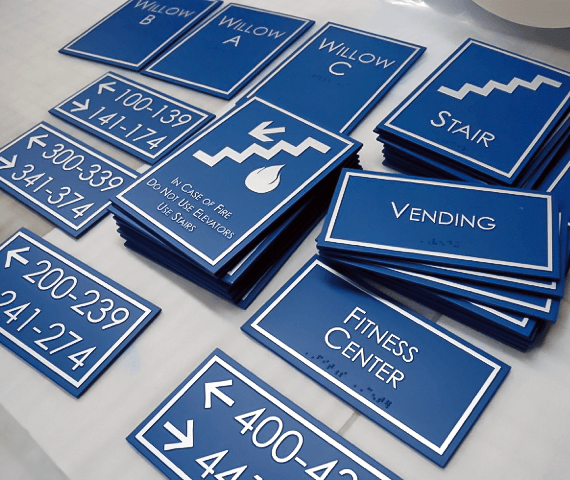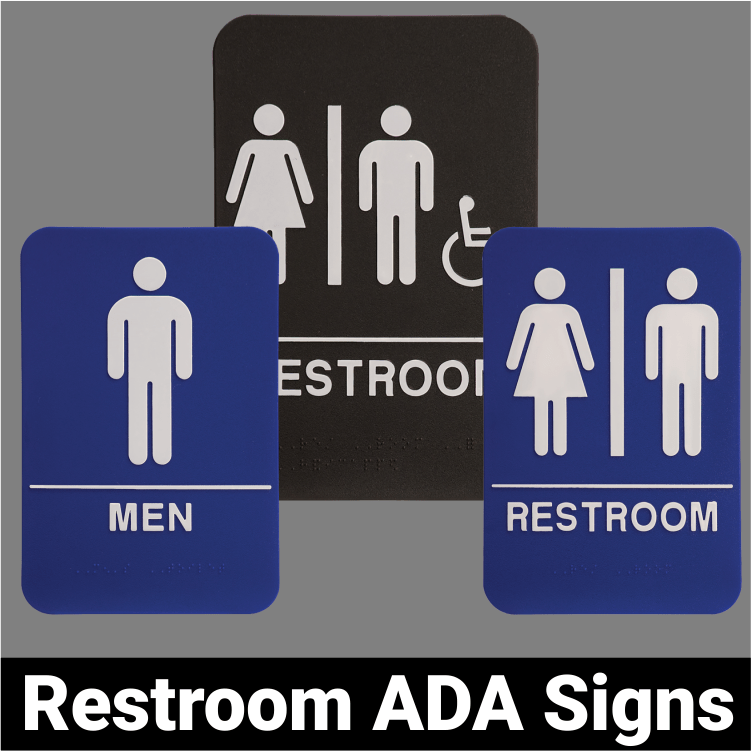Discover the Relevance of ADA Signs in Public Spaces
Discover the Relevance of ADA Signs in Public Spaces
Blog Article
ADA Signs: Making Certain Accessibility and Conformity in Public Spaces
ADA signage plays an important role in ensuring accessibility and compliance within public spaces, significantly adding to a comprehensive environment for people with handicaps. As we check out the nuances of ADA signs, from responsive features to design details, it's crucial to think about just how these components coalesce to copyright the legal rights of all users.
Importance of ADA Signage
In modern-day society, the value of ADA signs expands beyond plain compliance with lawful mandates to embody a commitment to inclusivity and access for all individuals. These indicators are necessary in creating environments where individuals with handicaps can browse public rooms with the same simplicity and freedom as those without disabilities. By providing clear and standardized information, ADA signage guarantees that everybody can access centers, services, and information without barriers.
The relevance of ADA signs lies in its ability to enhance the lifestyle for people with impairments by advertising equivalent accessibility. It removes the challenges that could or else prevent their ability to get involved completely in area life. These indicators offer as visible signs of a company's commitment to variety and equal rights, reflecting wider social worths that champion the civil liberties and dignity of all people.
Additionally, ADA signage plays an essential role in public security. By directing individuals to exits, washrooms, and other necessary facilities, it makes certain that all individuals, no matter of physical capability, can evacuate securely during emergency situations. In summary, ADA signs is not simply a regulative requirement however a powerful device for cultivating a comprehensive and equitable culture.
Trick Aspects of Compliance

Positioning is important; indications need to be mounted in areas that are conveniently visible and reachable. Usually, signs needs to be placed between 48 and 60 inches from the ground to guarantee access for both standing and mobility device users. Tactile elements, such as Braille, are important for individuals with visual impairments, providing critical info in a non-visual style.
High-contrast shades in between the message and background are needed to enhance readability for people with low vision. The ADA mandates certain contrast ratios to make sure clearness. In addition, character size is a crucial consideration, with minimum height needs dictated by the watching range to make sure readability from numerous angles.
Design Considerations for Availability
Creating easily accessible signs needs a meticulous technique to guarantee it meets the demands of all individuals, particularly those with handicaps. This involves taking into consideration numerous design aspects that improve readability and usability. Trick elements include the selection of typeface, color comparison, and responsive attributes. Fonts must be sans-serif, with clear and easy letterforms, to facilitate very easy analysis. The size of the message is equally vital, with ADA standards recommending a minimal height based upon viewing distance to make sure readability.
Contrasting colors between message and background are essential for presence, particularly for people with aesthetic problems. Additionally, responsive components, such as Braille and increased personalities, are important for people who are blind or have low vision.
Moreover, the positioning of signs plays a considerable duty in accessibility. Indicators should be installed in places that are unhampered and quickly obtainable. Making sure that signs is placed at appropriate heights and angles enables all customers, including those making use of mobility devices, to engage with them effectively.
Typical Blunders to Avoid

Another prevalent error is the incorrect placement of signs. ADA standards define exact height and area needs to make certain that indicators are easily noticeable and reachable by all individuals, consisting of those making use of wheelchairs. Neglecting these standards not just hinders accessibility but additionally risks non-compliance with lawful criteria.
Additionally, insufficient comparison in between message and history is a constant oversight. Sufficient comparison is vital for readability, specifically for people with low vision. Developers occasionally pick colors that are visually attractive yet lack the required contrast, making the text difficult to recognize.
Finally, some developers fail to incorporate tactile components, such as Braille, which are crucial for people who are blind. Leaving out i thought about this these features not just causes non-compliance with ADA guidelines but also restricts accessibility for a sector of the population that depends on responsive info.
Future Trends in Signage
Innovations in innovation and boosting recognition of inclusivity are shaping the future fads in signage style. As culture comes to be much more aware of varied requirements, the integration of clever modern technologies right into signs is gaining traction. Digital signage, for example, is advancing to include real-time updates and interactive attributes, which can be critical in offering vibrant information web in public areas. These indicators often integrate touch displays or gesture-based controls, making it possible for customers to navigate material customized to their details demands.
An additional arising fad is the application of increased fact (AR) to improve customer experience. AR-enabled signage can overlay digital details onto the physical setting, offering aesthetically impaired individuals with auditory or haptic feedback. ADA Signs. This technology not only enhances access yet additionally creates an appealing experience for all customers
Sustainability is additionally a considerable element influencing signs patterns. Environment-friendly products and energy-efficient illumination remedies are being prioritized to line up with worldwide ecological goals. Moreover, improvements in materials science are causing the development of even more weather-resistant and long lasting indications.
Final Thought
ADA signs plays an important function in assuring availability and compliance within public spaces by integrating responsive elements, high-contrast colors, and critical placement. The adherence to ADA standards not just assists in secure navigation for people with impairments however additionally signifies an organization's commitment to variety and inclusivity. By preventing usual blunders and embracing future trends, public spaces this hyperlink can remain to advance these values, guaranteeing that the rights and dignity of all individuals are respected and maintained.
ADA signs plays an indispensable duty in assuring ease of access and compliance within public areas, dramatically adding to a comprehensive atmosphere for people with handicaps. As we check out the nuances of ADA signs, from responsive features to make details, it's critical to take into consideration exactly how these aspects integrate to promote the civil liberties of all individuals.In contemporary culture, the relevance of ADA signs extends past plain compliance with lawful mandates to personify a commitment to inclusivity and ease of access for all people. By offering clear and standard info, ADA signage makes sure that everyone can access facilities, services, and info without barriers.
ADA signage plays a crucial function in guaranteeing accessibility and conformity within public spaces by incorporating responsive elements, high-contrast shades, and tactical placement. (ADA Signs)
Report this page